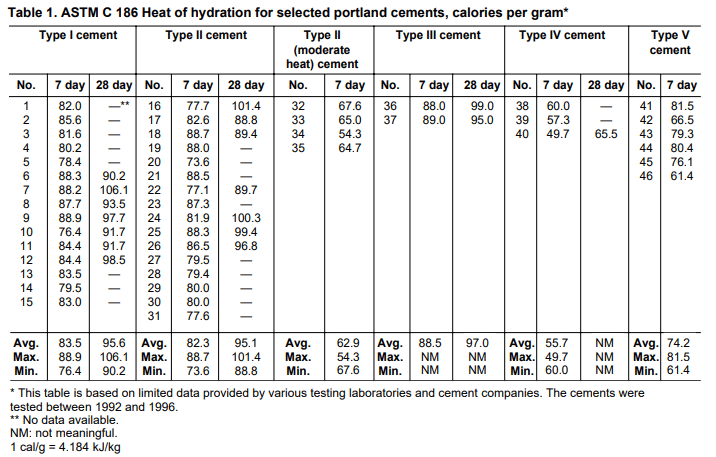Low heat cement is also the name given to the type of cement that produces low heat of hydration during its initial chemical reaction.
According to the ASTM C150 cement classification, these types of cement are classified as Type IV – Low Thermal Hydration.
Additionally, cement with low thermal conductivity is also classified as Type LH (low heat of hydration) based on its performance as per ASTM C1157.
Of the four main components of concrete, C is 3 S and C 3 A are the main contributors to the heat generated in the hydration process.
The amount of C 3 S and C 3 For low temperature cement, A will be reduced and the hydration process will be slow. As a result, the temperature rise is limited.


As shown in the ASTM C186 table above, the average heat generation of Type IV cement is low compared to other types of Portland cement.
Why do we need cement with low thermal conductivity?
Increased heat of hydration in concrete leads to cracks in concrete. We need to limit the temperature rise to prevent cracking.
Furthermore, even if there is reinforcement, cracks appear in the concrete due to strong heating.
There are several alternatives for this.
- Use low melting point cement
- Add fly ash
- Reduce the temperature of concrete when pouring using several methods.
- Concrete cooling during the hydration process.
The article Limiting Methods Concrete Temperature For more information on other methods (2-4 methods in the list) to limit heat build-up in concrete, see.
Of the above methods, using low-temperature glue (if available) is the easiest.
It is often used in large structures such as dams. These structures involve pouring a large amount of concrete. This concrete is subject to cracking due to the heat generated in the hydration process.
As cracks in concrete seriously affect the operability and durability of structures such as dams, it is very important to prevent cracks. Furthermore, in some structures there are no reinforcements, which is more critical in terms of cracking.
Therefore, using low heat capacity cement to reduce heat of hydration whenever possible is a good option.
Some important information
- As the heat increase in the hydration process is smaller, the increase in core temperature, the temperature difference between the core and the surface, and the temperature gradient are reduced.
- The initial increase in strength is slow, but it becomes stronger over time and a significant improvement in strength is seen.
- Excellent resistance to drying shrinkage.
- Excellent durability performance.
- High resistance to chemical attacks.
- These types of cement cannot be used in cold environments.
- The cost of cement can be higher than other types of common Portland cement. cement .

